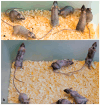Effect of Free Long-Chain Fatty Acids on Anagen Induction: Metabolic or Inflammatory Aspect?
- PMID: 40141208
- PMCID: PMC11941852
- DOI: 10.3390/ijms26062567
Effect of Free Long-Chain Fatty Acids on Anagen Induction: Metabolic or Inflammatory Aspect?
Abstract
Hair growth is a highly complex process regulated at multiple levels, including molecular pathways, stem cell behavior, metabolic processes, and immune responses. The hair follicle exhibits metabolic compartmentalization, with some cells relying on glycolysis and others on oxidative phosphorylation. Interestingly, in mice, the onset of the anagen phase can be stimulated by locally suppressing oxidative phosphorylation in the skin. This study showed that topical application of palmitate or oleate accelerated the onset of anagen in mice, while lactate, the end product of glycolysis, delayed it. We also investigated the effects of fatty acids on cytokine production in various human cell cultures. Fatty acids did not induce a cytokine response in fibroblasts or keratinocytes but significantly affected monocytes. Specifically, palmitic acid induced the production of TNF-α, IL-8, and CCL2. Oleic acid, however, elicited almost no response. By comparing the "metabolic" and "inflammatory" hypotheses of anagen stimulation, the results of our study suggest that metabolic regulation holds significant promise for influencing hair growth.
Keywords: free fatty acids; glycolysis; hair growth; inflammation; lactate; metabolic reprogramming.
Conflict of interest statement
The authors declare no conflicts of interest.
Figures






Similar articles
-
The effect of cilostazol, a phosphodiesterase 3 (PDE3) inhibitor, on human hair growth with the dual promoting mechanisms.J Dermatol Sci. 2018 Jul;91(1):60-68. doi: 10.1016/j.jdermsci.2018.04.005. Epub 2018 Apr 11. J Dermatol Sci. 2018. PMID: 29678305
-
Saturated long-chain fatty acids activate inflammatory signaling in astrocytes.J Neurochem. 2012 Mar;120(6):1060-71. doi: 10.1111/j.1471-4159.2012.07660.x. Epub 2012 Feb 6. J Neurochem. 2012. PMID: 22248073 Free PMC article.
-
Stimulatory effect of Brazilian propolis on hair growth through proliferation of keratinocytes in mice.J Agric Food Chem. 2014 Dec 10;62(49):11854-61. doi: 10.1021/jf503184s. Epub 2014 Nov 26. J Agric Food Chem. 2014. PMID: 25418897
-
A novel and safe small molecule enhances hair follicle regeneration by facilitating metabolic reprogramming.Exp Mol Med. 2018 Dec 6;50(12):1-15. doi: 10.1038/s12276-018-0185-z. Exp Mol Med. 2018. PMID: 30523246 Free PMC article.
-
Enhancing hair follicle regeneration by nonablative fractional laser: Assessment of irradiation parameters and tissue response.Lasers Surg Med. 2015 Apr;47(4):331-41. doi: 10.1002/lsm.22330. Epub 2015 Apr 10. Lasers Surg Med. 2015. PMID: 25866259
References
MeSH terms
Substances
Grants and funding
LinkOut - more resources
Full Text Sources

